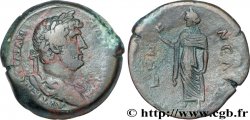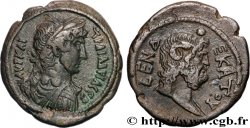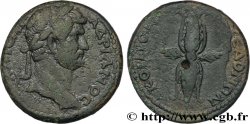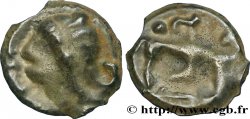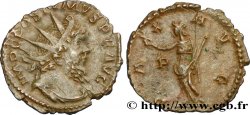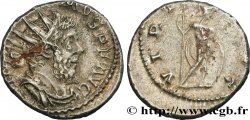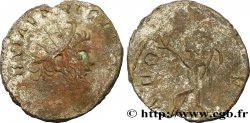E-auction 95-49564 - bpv_296080 - HADRIAN Tétradrachme syro-phénicien
You must signin and be an approved bidder to bid, LOGIN TO BID. Accounts are subject to approval and the approval process takes place within 48 hours. Do not wait until the day a sale closes to register. Clicking on « bid » constitutes acceptance of the terms of use of cgb.fr private e-auctions.
Bids must be placed in whole Euro amounts only. The sale will start closing at the time stated on the item description; any bids received at the site after the closing time will not be executed. Transmission times may vary and bids could be rejected if you wait until the last second. For further information ckeck the E-auctions F.A.Q.
NO BUYER'S FEE.
NO BUYER'S FEE.
| Estimate : | 120 € |
| Price : | 45 € |
| Maximum bid : | 49 € |
| End of the sale : | 09 February 2015 16:12:00 |
| bidders : | 6 bidders |
Type : Tétradrachme syro-phénicien
Date: 132-133
Mint name / Town : Aigeai, Cilicie
Metal : silver
Diameter : 25,5 mm
Orientation dies : 6 h.
Weight : 13,10 g.
Rarity : R1
Coments on the condition:
Décentrement et plat de frappe au droit
Catalogue references :
Predigree :
Cet exemplaire est le 0720A_037 de la base TSP
Obverse
Obverse description : Buste lauré et cuirassé d’Hadrien à droite, vu de trois-quarts de face (B*01), sans drapé sur l’épaule gauche, broche courte sous le cou.
Obverse legend : AUTOK KAIS TRAIANOS ADRIANOS SEB (Autokratoros Kaisaros Traianos Adrianos Sebastos)
Obverse translation : (L’empereur césar Trajan Hadrien auguste).
Reverse
Reverse description : Aigle de face, ailes déployées, tête et queue à droite, sur une ligne de terre, une chèvre à droite à l’exergue.
Reverse legend : AIGEAIWN/ ETOUS QOR
Reverse translation : (D’Aigeai, an 179 de l’ère césarienne).
Commentary
À la lumière des nouveaux exemplaires révélés par une trouvaille récente, il a été nécessaire de subdiviser le type Prieur 720 en deux avec le 720 standard où le buste a un gros drapé sur l’épaule gauche avec une grosse broche et le 720A où le buste n’a qu’une très petite boucle.
Aigeai était située sur le golfe d'Issos, à l'opposé d'Alexandrie fondée par Alexandre III le Grand afin de commémorer la grande bataille qui avait opposé les Grecs et les Perses en 333 avant J.-C. C’était un port important. Le choix de la chèvre dans le champ à droite est lié à un jeu de mot entre le nom AIGEIWN (des chèvres) et le nom de la cité (AIGEIAWN).
On ignore pourquoi Aigeai, dont les frappes autonomes, excessivement rares, s’interrompent en 30 avant J.-C. va frapper, sous Hadrien, une série importante et variée, à plusieurs faciales, aux types souvent recherchés, incluant même Sabine sur certains revers.
Il est probable, de la même manière que nous avons une rarissime émission commémorative de la ville sous Caracalla, que la motivation est le séjour de l’Empereur dans la ville et le motif de son séjour, le même que sous Caracalla, le temple d’Asclépios et d’Hygie, les divinités de la Médecine.
Il y eut probablement en réalité deux séjours, le premier vers 117/118 AD, où sont frappés une série de tridrachmes dont l’un au revers d’Hygie et du serpent,
L’autre passage se situe vers 130/134, sur un rythme annuel avec une émission de tétradrachmes comme le nôtre, au revers de l’aigle, poids moyen vers 13,5 g, et en 133/134 une série de tridrachmes à flan large et à l’aspect de tétradrachmes, d’un poids moyen oscillant autour de 9,5 g, uniquement des émissions commémoratives (Sabine, Asclépios, pas de revers à l’aigle).
Ces émissions sont importantes car elles se placent entre les usages de Césarée pour les poids et ceux d’Antioche pour le type et l’aspect.
On doit noter que cette émission, contrairement à celle de 130/131 mais comme les suivantes, écrit les S en sigma et non pas en C.
Dans la base TSP maintenue par Michel Prieur, trente-sept exemplaires sont maintenant répertoriés pour le 720A, un seul en musée, à Oxford.
In light of the new specimens revealed by a recent find, it was necessary to subdivide the Prieur 720 type into two with the standard 720 where the bust has a large drape on the left shoulder with a large brooch and the 720A where the bust has only a very small loop.
Aigeai was located on the Gulf of Issus, opposite Alexandria, founded by Alexander III the Great to commemorate the great battle between the Greeks and the Persians in 333 BC.. -C. It was an important port. The choice of the goat in the field on the right is linked to a play on words between the name AIGEIWN (goats) and the name of the city (AIGEIAWN).
It is not known why Aigeai, whose autonomous strikes were extremely rare, stopped in 30 BC.. -C. will strike, under Hadrian, an important and varied series, with several facial features, with often sought-after types, even including Sabine on certain reverses.
It is likely, in the same way that we have a very rare commemorative issue of the city under Caracalla, that the motivation is the stay of the Emperor in the city and the reason for his stay, the same as under Caracalla, the temple of Asclepius and Hygieia, the divinities of Medicine.
There were probably two stays, the first around 117/118 AD, where a series of tridrachms were struck, one of which had the reverse of Hygieia and the serpent. The other passage is around 130/134, on an annual basis with an issue of tetradrachms like ours, with the reverse of the eagle, average weight around 13.5 g, and in 133/134 a series of tridrachms with a wide flan and the appearance of tetradrachms, with an average weight oscillating around 9.5 g, only commemorative issues (Sabine, Asclepius, no reverse with the eagle).
These emissions are important because they are placed between the customs of Caesarea for weights and those of Antioch for type and appearance.
It should be noted that this issue, unlike that of 130/131 but like the following ones, writes the S in sigma and not in C.
In the TSP database maintained by Michel Prieur, thirty-seven examples are now listed for the 720A, only one in a museum, in Oxford
Aigeai était située sur le golfe d'Issos, à l'opposé d'Alexandrie fondée par Alexandre III le Grand afin de commémorer la grande bataille qui avait opposé les Grecs et les Perses en 333 avant J.-C. C’était un port important. Le choix de la chèvre dans le champ à droite est lié à un jeu de mot entre le nom AIGEIWN (des chèvres) et le nom de la cité (AIGEIAWN).
On ignore pourquoi Aigeai, dont les frappes autonomes, excessivement rares, s’interrompent en 30 avant J.-C. va frapper, sous Hadrien, une série importante et variée, à plusieurs faciales, aux types souvent recherchés, incluant même Sabine sur certains revers.
Il est probable, de la même manière que nous avons une rarissime émission commémorative de la ville sous Caracalla, que la motivation est le séjour de l’Empereur dans la ville et le motif de son séjour, le même que sous Caracalla, le temple d’Asclépios et d’Hygie, les divinités de la Médecine.
Il y eut probablement en réalité deux séjours, le premier vers 117/118 AD, où sont frappés une série de tridrachmes dont l’un au revers d’Hygie et du serpent,
L’autre passage se situe vers 130/134, sur un rythme annuel avec une émission de tétradrachmes comme le nôtre, au revers de l’aigle, poids moyen vers 13,5 g, et en 133/134 une série de tridrachmes à flan large et à l’aspect de tétradrachmes, d’un poids moyen oscillant autour de 9,5 g, uniquement des émissions commémoratives (Sabine, Asclépios, pas de revers à l’aigle).
Ces émissions sont importantes car elles se placent entre les usages de Césarée pour les poids et ceux d’Antioche pour le type et l’aspect.
On doit noter que cette émission, contrairement à celle de 130/131 mais comme les suivantes, écrit les S en sigma et non pas en C.
Dans la base TSP maintenue par Michel Prieur, trente-sept exemplaires sont maintenant répertoriés pour le 720A, un seul en musée, à Oxford.
In light of the new specimens revealed by a recent find, it was necessary to subdivide the Prieur 720 type into two with the standard 720 where the bust has a large drape on the left shoulder with a large brooch and the 720A where the bust has only a very small loop.
Aigeai was located on the Gulf of Issus, opposite Alexandria, founded by Alexander III the Great to commemorate the great battle between the Greeks and the Persians in 333 BC.. -C. It was an important port. The choice of the goat in the field on the right is linked to a play on words between the name AIGEIWN (goats) and the name of the city (AIGEIAWN).
It is not known why Aigeai, whose autonomous strikes were extremely rare, stopped in 30 BC.. -C. will strike, under Hadrian, an important and varied series, with several facial features, with often sought-after types, even including Sabine on certain reverses.
It is likely, in the same way that we have a very rare commemorative issue of the city under Caracalla, that the motivation is the stay of the Emperor in the city and the reason for his stay, the same as under Caracalla, the temple of Asclepius and Hygieia, the divinities of Medicine.
There were probably two stays, the first around 117/118 AD, where a series of tridrachms were struck, one of which had the reverse of Hygieia and the serpent. The other passage is around 130/134, on an annual basis with an issue of tetradrachms like ours, with the reverse of the eagle, average weight around 13.5 g, and in 133/134 a series of tridrachms with a wide flan and the appearance of tetradrachms, with an average weight oscillating around 9.5 g, only commemorative issues (Sabine, Asclepius, no reverse with the eagle).
These emissions are important because they are placed between the customs of Caesarea for weights and those of Antioch for type and appearance.
It should be noted that this issue, unlike that of 130/131 but like the following ones, writes the S in sigma and not in C.
In the TSP database maintained by Michel Prieur, thirty-seven examples are now listed for the 720A, only one in a museum, in Oxford








 Report a mistake
Report a mistake Print the page
Print the page Share my selection
Share my selection Ask a question
Ask a question Consign / sell
Consign / sell
 Full data
Full data